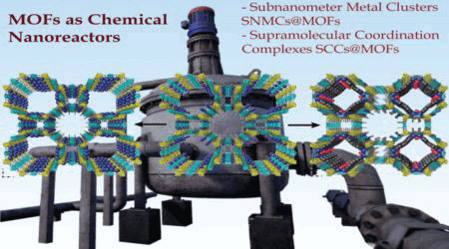Acc. Chem. Res. 2020, 53, 2, 520-531
Since the advent of the first metal-organic frameworks (MOFs), we have witnessed an explosion of captivating architectures with exciting physicochemical properties and applications in a wide range of fields. This, in part, can be understood under the light of their rich host-guest chemistry and the possibility to use single-crystal X-ray diffraction (SC-XRD) as basic characterization tool. Moreover, chemistry on preformed MOFs, applying recent developments in template-directed synthesis and post-synthetic methodologies (PSMs), has shown as a powerful synthetic tool to (i) tailor MOFs channels of known topology via single-crystal to single-crystal (SC-SC) processes, (ii) impart higher degrees of complexity and heterogenenty within them, and most importantly, (iii) improve their capabilities towards applications respect the parent MOFs. However, the unique properties of MOFs have been, somehow, limited and underestimated. This is clearly reflected on the use of MOFs as chemical nano-reactors, which have been barely uncovered. In this Accounts, we bring together our recent advances on the construction of MOFs with appealing properties, to act as chemical nano-reactors and be used to synthesise and stabilize –within their channels– catalytically-active species that otherwise could be hardly accessible. Firstly, through two relevant examples, we present the potential of the metalloligand approach to build highly robust and crystalline oxamato- and oxamidato-MOFs with tailored channels, in terms of size, charge and functionality. These are initial requisites to have a playground where we can develop and fully take advantage of singular properties of MOFs, as well as visualize/understand the procees that take place within MOFs pores, and somehow make structure-functionalities correlations and develop more performant MOFs nano-reactors. Then, we describe how to exploit the unique and singular features that offer each of these MOFs confined space for (i) the incorporation and stabilization of metals salts and complexes, (ii) the in-situ stepwise synthesis of sub-nanometric metal clusters (SNMCs) and (iii) the confined-space self-assembly of supramolecular coordination complexes (SCCs), by means of PSMs and underpinned by SC-XRD. The strategy outlined here has led to unique rewards such as the highly challenging gram-scale preparation of stable and well-defined ligand-free SNMCs, exhibiting outstanding catalytic activities and the preparation of unique SCCs –different to those assembled in solution– with enhanced stabilities, catalytic activities, recyclabilities and selectivities. The results presented in this Accounts are just few recent exponents, but highly encouraging, of the large potential way of MOFs as chemical nano-reactors. More work is needed to found the boundaries and fully understand the chemistry in the confined space. In this sense, mastering the synthetic chemistry of discrete organic molecules and inorganic complexes have basically changed our way of live. Thus, achieving the same degree of control on extended hybrid networks will open new frontiers of knowledge with unforeseen possibilities. We aim to stimulate the interest of researchers working abroad differents fields to fully unleash the host-guest chemistry in MOFs as chemical nano-reactors with exclusive functional species.

